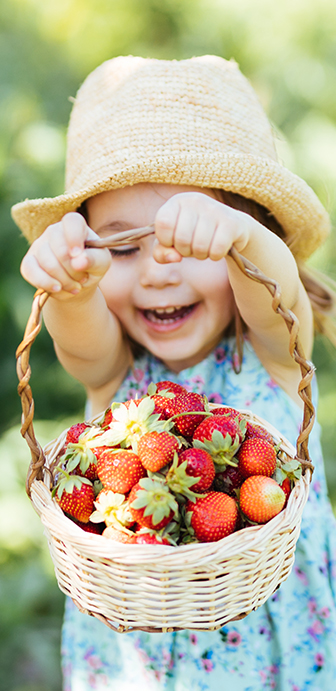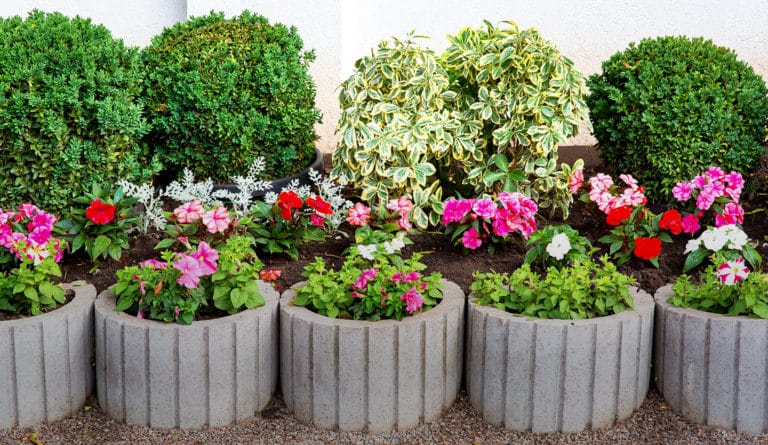
strawberries
aka Fragaria × Ananassa
Forget those grocery store imposters! Your garden-grown strawberries will remind you how delicious a berry can be. Some like a little sprinkle of sugar but we think they’re perfect as-is.
variations
Three major varieties of strawberries: June-bearing, ever-bearing, and day-neutral strawberries, each with a different time and duration of fruiting.
light
full sun
These sun-loving plants will happily take 6 to 10 hours. They’re okay in shadier spots, but don’t expect as many berries (aka the entire point of strawberry plants).
water + feeding
average needs
Natural rainfall is often enough. But keep an eye on the weather. If it’s hot and dry, water about 1 inch per week (about 30 minutes total sprinkler time). Water more when the plant is establishing. It has shallow roots that need encouragement.
toxic
non-toxic
Safe and delicious, for humans and pampered pets alike.
size
small-ish
Smaller Strawberry plants grow to about 6 to 8 inches tall, and about 1 ft wide.
pro tip
snip, don’t pluck
Plucking the fruit can damage the delicate plant. Use a little pair of scissors to snip the stems just above the fruit.
fun fact
teeny seeds
The average strawberry has 200 extremely tiny seeds. Could they be any more cute!?


beyond the basics
-
soil & potting
Strawberries can handle a range soil types, but loamy well-draining soil is best. If your soil is clay dominant, consider mixing in compost or peat moss.
-
companion planting
Crop rotation tip: avoid planting strawberries where you recently planted eggplants, pepper, tomatoes or even other strawberries. Beneficial herbs to plant around Strawberries include Garlic, Mint, Sage and Thyme. Beneficial veggies include beans, lettuce, onions and spinach. For flowers, marigolds add a pop of colour and are great at repelling slugs and other insect pests.
-
harvesting
Once you see flowers, the countdown is on! Usually 4 to 6 weeks ‘til harvest time. Pick the plant regularly, as often as every 3 days.
-
pest control
Keep free of nutrient-stealing weeds. A gritty mulch or some sand on top of the soil will deter slugs.

troubleshooting
-
why are my plant’s leaves turning brown?
Likely not enough water. They’re trying to give you those juicy berries right at the start of summer. It’s best to water in the morning or late evening, when the hot sun can’t bake it away.
-
turning yellow or dying?
Probably poor soil conditions. Potted Strawberry plants from a grocery store or department store often come in poor quality soil. To give your strawberry plant the nutrients it’s craving, transplant to soil enriched with compost, or go with a new vegetable soil mix.
If your plant is in a garden bed that hasn’t been replenished with fertilizer or plant food, they may also be starved for nutrients. Supplement with plant food such as Miracle-Gro® Organics Plant Food.
-
why aren’t my strawberry plants producing fruit?
Too much heat and not enough water. If the late Spring is hot and dry, and Summer’s looking like more of the same, it’s time to increase watering. Hydrated plants give you more berries. Try 1 inch per week (about 30 minutes total sprinkler time).
-
what’s causing these black, purple, or red spots on the leaves?
Some pests also love eating strawberry plants, namely aphids, mites, slugs, and weevils. Check the leaves. All these little monsters can be handled with a vegetable-safe pesticide.
Another cause could be common leaf spot. These fungal spots range in colour from dark red to dark purple, to black. It’s carried on the wind from other plants and is spread most easily through watering and periods of rain. This is usually just a cosmetic issue. You can remove badly infected leaves, and water at soil level to help slow the spread.
-
why are my plants scraggly or ‘leggy’?
If your seedlings are growing up leggy, it’s usually the basics. Water and light. They want bright light for 6 to 10 hours a day, and plenty of watering when they’re starting out.



